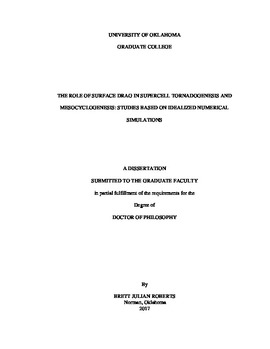| dc.description.abstract | Idealized numerical simulations of supercell thunderstorms have been employed for several decades to study tornadogenesis, providing valuable insights that have helped shape our current understanding of the process. Until the past several years, however, most of these simulations used a free-slip lower boundary condition, effectively disregarding the effects of surface drag. In this study, 50-m (tornado-resolving) idealized simulations of a supercell thunderstorm are performed using the Advanced Regional Prediction System (ARPS) with parameterized surface drag. Analyses of the dynamics of low-level mesocyclogenesis and tornadogenesis are conducted.
Two sets of experiments are performed and analyzed in this study. First, a pair of experiments is performed to identify mechanisms by which drag affects storm behavior. In the first experiment (full-wind drag), surface drag is applied to the full wind components; in the second experiment (environmental drag), drag is applied only to the background environmental wind, with storm-induced perturbations unaffected. In the full-wind drag experiment, a tornado develops around 25 min into the simulation and persists for more than 10 min; in the environmental drag experiment, no tornado occurs. An important mechanism leading to tornadogenesis in the full-wind drag experiment is the generation of near-ground crosswise horizontal vorticity by drag on the storm scale as inflow air accelerates into the low-level mesocyclone; this vorticity is subsequently exchanged into the streamwise direction and eventually tilted into the vertical. Preceding tornadogenesis, the low-level mesocyclone in the full-wind drag experiment also intensifies and lowers rapidly toward the ground, which does not occur in the environmental drag experiment. Circulation budgets for material circuits enclosing the low-level mesocyclone reveal substantial generation of new circulation by surface drag in the full-wind drag experiment, while the mesocyclone circulation in the environmental-drag experiment is primarily barotropic in origin.
A second set of experiments is performed in which the drag coefficient (Cd) is varied over a range of values appropriate for water and land. The initial low-level mesocyclone lowers toward the ground, intensifies, and produces a tornado in all experiments with Cd > 0, with the intensification occurring earlier for larger Cd; in the no-drag experiment, the low-level mesocyclone remains comparatively weak during this period. Circulation budgets for material circuits initialized around the mesocyclone again implicate surface drag acting in the inflow region as having generated important new circulation. Although a greater relative contribution from drag is seen as Cd increases, the difference between the last two experiments (Cd = 0.02, Cd = 0.05) is minimal and the tornado in the latter experiment is weaker, suggesting an upper limit on the drag coefficient for the favorability of this circulation-generating mechanism. Later in the simulations, after precipitation-driven outflow encloses much of the near-ground mesocyclone, tornadoes in experiments with large Cd tend to be weaker and shorter-lived than those in experiments with small Cd. Circulation analysis of a tornado in one strong-drag experiment suggests that the previously described mechanism may still be important even for tornadoes in this context, where baroclinic vorticity is readily available near the vortex. Implications of the proposed roles of surface drag in supercell tornadogenesis dynamics are discussed, and suggestions for future work are offered. | en_US |
